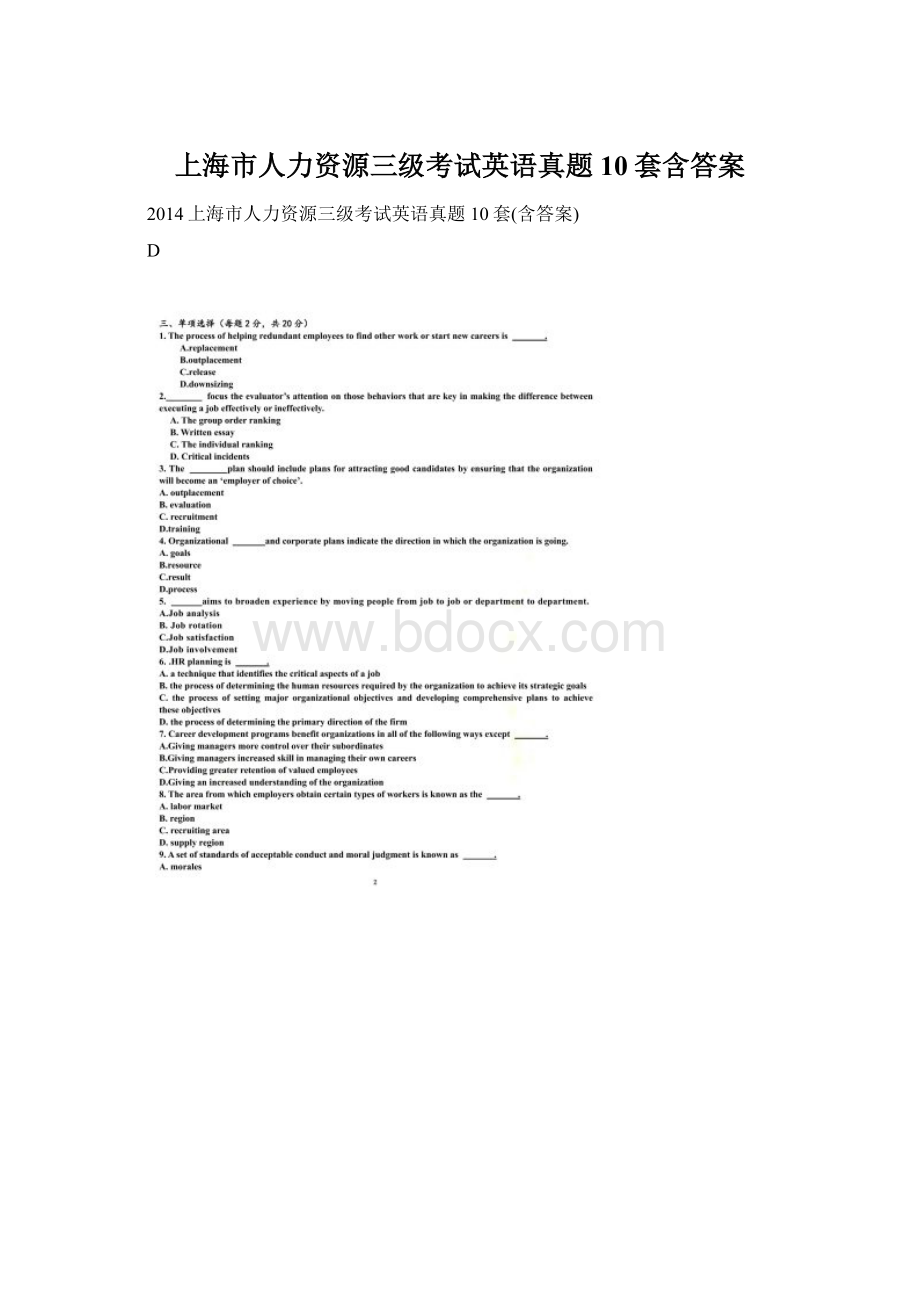上海市人力资源三级考试英语真题10套含答案Word文档下载推荐.docx
《上海市人力资源三级考试英语真题10套含答案Word文档下载推荐.docx》由会员分享,可在线阅读,更多相关《上海市人力资源三级考试英语真题10套含答案Word文档下载推荐.docx(39页珍藏版)》请在冰豆网上搜索。

4.Thejobspecificationdescribesjobrequirementsrelativeto.
A.skillandphysicaloutputs
B.skillandphysicaldemands
C.ageandphysicaldemands
D.experienceandphysicaldescription
5.Whendeterminingwheretrainingemphasisshouldbeplaced,anexaminationofthegoals,resources,andenvironmentoftheorganizationisknownas.
A.taskanalysis
B.organizationanalysis
C.resourceanalysis
D.skillsanalysis
6.Thejobevaluationsysteminwhichspecificelementsofthejobstobeevaluatedarecomparedagainstsimilarelementsofkeyjobswithintheorganizationisknownas.
A.thepointmethod
B.jobranking
C.thecomparisonmethod
D.theHayprofilemethod
7.Thefinaldecisiontohireanapplicantusuallybelongsto.
A.theHRrecruiter
B.theHRmanager
C.linemanagement
D.co-workers
8.Determiningwhatthecontentofatrainingprogramshouldbe,basedonastudyofthejobduties,isknownas.
A.organizationanalysis
B.individualanalysis
C.jobanalysis
D.taskanalysis
9.Sometimesorganizationsprovideservicestoterminatedemployeesthathelpthembridgethegapbetweentheiroldpositionandanewjob.Theseservicesareknownas.
A.downsizingprograms
B.“headhunting”assistanceprograms
C.outplacementassistance
D.employeeassistanceprograms(EAPs)
10.Jobformthebasisfortheadministrationofapplicableemploymenttests.
A.outlines
B.specifications
C.requirements
D.details
Answer:
1.C2.D3.C4.B5.B6.C7.C8.D9.C10.B
四、阅读理解(每题3分,共30分)
1.Multipersoncomparisonsisa(an)measuringdevice.
A.absolute
B.relative
C.accurate
D.false
2.Accordingtothepassage,therearethreemostpopularcomparisonsexcept.
A.grouporderranking
B.individualranking
C.graphicratingscales
D.pairedcomparisons
3.Fromthispassage,wecaninferthat.
A.recommendingstudentstograduateschoolsoftenusesindividualranking
B.thepairedcomparisonapproachassumesthatthedifferencebetweenthefirstandsecondemployeeissame
C.grouporderrankingensuresthateachemployeeiscomparedagainsteveryother
D.eachmethodofmultipersoncomparisonscanbeusedsimultaneously
4.Thefollowingstatementsaboutindividualrankingarefalseexcept.
A.itrankordersofemployeesfromfromthelowestperformeruptothehighest
B.theresultisacleanorderingofemployees
C.itassumesthatthedifferencebetweenthefirstandsecondemployeeisdifferent
D.thisapproachallowsforsomeoftheemployeeswhomaybecloselygrouped
5.Thisarticlemightbeextractedfromthepaperabout.
A.performanceappraisal
B.recruitmentandreplacement
C.traininganddevelopment
D.rewardsystems
1.B2.C3.D4.B5.A
(二)
1.Rewardsareoftencnsideredasafunctioninhumanresourcemanagement.
A.planning
B.leading
C.motivating
D.controlling
2.Extrinsicrewardsincludethefollowingexcept.
A.jobenrichment
B.directcompensation
C.indirectcompensation
D.nonfinancialrewards
3.Accordingtothepassage,thefollowingstatementsarefalseexcept.
A.Nonfinancialrewardsbelongtointrinsicrewards.
B.Overtimeandholidaypremiumpaybelongstoindirectcompensation.
C.Employeeswillexpecttheirdirectcompensationtobecomparabletotheindirectcompensationgiventootheremployeeswithsimilarabilitiesandperformance.
D.Employeeswillexpecttheirdirectcompensationgenerallytoalignwiththeirassessmentoftheircontributiontotheorganization.
4.Perquisiteswhichtheorganizationprovidesemployeesbelongto.
A.intrinsicrewards
5.Theauthorofthispassagewouldmostlikelyagreethat.
A.Ifindirectcompensationiscontrollablebymanagement,thenitcan’tbeconsideredasamotivatingreward.
B.Ifindirectcompensationsaremadeuniformlyavailabletoallemployeesatagivenjoblevel,regardlessofperformance,theywilllosetheirmotivatingfunction.
C.Techniqueslikejobenrichmentornonfinancialrewardstoincreasepersonalworthtotheemployeemaymakehisorherworkmoreintrinsicallyrewarding.
D.Eachtypeofrewardscanbedistributedonanindividualorgroup,notorganizationwidebasis.
1.C2.A3.D4.C5.B
1.Thetendencyforanevaluatortolettheassessmentofanindividualononetraitinfluencehisorherevaluationofthatpersononothertraitsisknownas.
A.similarityerror
B.haloeffectorerror
C.leniencyerror
D.singlecriterion
2.Theperformanceevaluationapproachwhichcompareseachemployeewitheveryotheremployeeandrateseachaseitherthesuperiorortheweakermemberofthepairisknownas.
A.thepairedcomparison
B.theindividualranking
C.thegrouporderranking
D.criticalincidents
3.Determiningwhetherornottaskperformanceisacceptableandstudyingthecharacteristicsofindividualsandgroupsthatwillbeplacedinthetrainingenvironmentareknownas.
A.personanalysis
B.demographicanalysis
C.individualanalysis
D.groupandindividualanalysis
4.Thelinesofadvancementforanindividualwithinanorganizationareknownas.
A.careerpaths
B.jobprogressions
C.careerlines
D.jobpaths
5.Freedomfromcriteriondeficiencyofperformanceappraisalsreferstotheextenttowhich.
A.standardsrelatetotheoverallobjectivesoftheorganization
B.standardscapturetheentirerangeofanemployee’sresponsibilities
C.individualstendtomaintainacertainlevelofperformanceovertime
D.factorsoutsidetheemployee’scontrolcaninfluenceperformance
6.TheHayprofilemethoduseswhichthreefactorsforevaluatingjobs?
.
A.knowledge,skill,andresponsibility
B.mentalability,skill,andresponsibility
C.knowledge,mentalability,andresponsibility
D.knowledge,mentalability,andaccountability
7.Whichofthefollowingisnotanimportantcomponentofameaningfulgainsharingplan?
.
A.establishingfairandprecisemeasurementstandards
B.ensuringthatbonuspayoutformulasareeasytocalculate
C.ensuringthatbonuspayoutsarelargeenoughtoencouragefutureemployeeeffort
D.dependingontopmanagementtodevelopthegainsharingprogram
8.Givingemployeesmorecontroloverdecisionsaboutwhotheirco-workerswillbeisknownas.
A.empoweredselection
B.collaboration
C.teamselection
D.groupdevelopment
9.Whichofthefollowingisatechniqueusedtoelicitemployeeviewsinordertomakedecisionsandinitiatechange?
A.suggestionsystem
B.downwardcommunication
C.attitudesurvey
D.empowerment
10.Assessingthedegreetowhichwhatemployeeslearnedduringthetrainingprogramistranslatedintoenhancedemployeeperformanceisknownas.
A.resultsevaluation
B.reactionevaluation
C.behaviorevaluation
D.learningevaluation
1.B2.A3.A4.A5.B6.D7.D8.C9.C10.C
(一)
1.Atrainingoralearningspecificationisaproductof.
A.jobstructure
B.jobevaluation
C.jobdesign
D.jobanalysis
2.Accordingtothispassage,whichofthefollowingisn’tthecharacteristicorattributethattheindividualshouldhaveinordertoperformthetasksuccessfully?
A.knowledge
B.mentalability
C.competences
D.attitudes
3.Accordingtothispassage,theknowledgethattheindividualshouldhaveinordertoperformthetasksuccessfullymayincludethefollowingexcept.
A.professional,technicalorcommercialknowledge
B.knowledgeaboutthecommercial,economic,ormarketenvironment
C.knowledgeaboutthejobdescription
D.theproblemsthatoccurandhowtheyshouldbedealtwith
4.Fromthispassage,wecaninferthat.
A.Inordertoperformtaskssuccessfully,individualsneedknowmorethantheirprofessionalknowledge.
B.Inordertoperformtaskssuccessfully,skillsthattheindividualshouldhavearebuiltonlybyrepeatedtraining.
C.Inordertoperformtaskssuccessfully,thedispositiontobehaveortoperforminawayneedn’tbeinaccordancewiththerequirementsofthework.
D.Inordertoperformtaskssuccessfully,performancestandardsshouldbebasedonwhattheaverageindividualhastobeabletoachieve.
5.Thebesttitleofthispassageis.
A.jobanalysis
B.trainingorlearningspecification
C.jobdescription
D.performancestandards
1.D2.B3.C4.A5.B
1.Theword-“attrition”inthefirstparagraphmeans.
A.retentionrates
B.supplyfromwithintheorganization
C.supplyfromoutsidetheorganization
D.laborwastageandretirements
2.Accordingtothepassage,forcastingthefuturesupplyofpeopleshouldbebasedonthefollowingexcept.
A.forecastlossestoexistingresourcesthroughattrition
B.forecastchangestoexistingresourcesthroughexternalmovements
C.theeffectofchangingconditionsofwork
D.sourcesofsupplyfromexternallabormarkets
3.Theauthorofthispassagemightdisagreethat.
A.Thedemandandsupplyforecastscanbeanalyzedtodeterminewhetherthereareanydeficitsorsurplus.
B.Thedemandandsupplyforecastscan